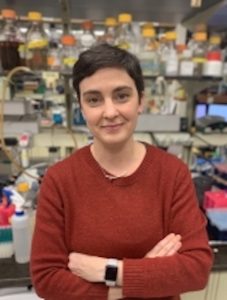Nine LSI research groups have been awarded funding through the Canadian Institutes of Health Research (CIHR) 2020 Fall round.
Drs. Douglas Allan, Yossef Av-Gay, David Fedida, Kenneth Harder, Jayachandran N. Kizhakkedathu, Lawrence McIntosh, Robert Molday and Filip Van Petegem, and Robert Nabi received full grants. Drs. Eric Jan, Michel Roberge and Ivan Sadowski received a special COVID operating grant, and Dr. Kota Mizumoto received a bridge grant. UBC as a whole received 33 awards out of 224 submissions.
Congratulations to all for this success in this highly competitive round!
 Dr. Douglas Allan
Dr. Douglas Allan
Neurons communicate via synapses. During development, synapses must grow and establish correct levels of communication. Failure to do so has major implications for neurological and psychiatric disorders during development and maturation. In adulthood, degeneration of synapses underlies many progressive degenerative disorders. Synapses are high energy places that need a constant supply of parts (or proteins) to make build themselves up and them carry out repairs and make adjustments. To get the right parts, synapses send requests back to the nucleus, which converts the request into the parts list that the synapse needs. Our project aims to figure out how the nucleus converts requests into the right type and number of parts, and to determine what some of these parts do at the synapse. We study this question during the developmental growth of motor neurons, which contact muscles to allow us to move and breath. Our work is directly relevant to motor neuron diseases, but we expect our work to provide fundamental understanding of this critical process that occurs in all other neurons. Failure of any part of this process is devastating to neuronal health, and underlies many disorders. This is because during early embryonic and childhood development, these parts sent by the nucleus are needed to help the synapse grow, establish communication and respond to developmental changes in brain function. In adulthood, these parts keep synapses in good repair and make necessary adjustments to keep the synapse working optimally. The Public Health Agency of Canada has reported that neurological conditions affect 3.6 million Canadians (~1/10th of the population), at a cost of billions in direct healthcare and family care costs. Given these devastating statistics, and our inability to effectively treat the majority of these disorders, it is critical that we make headway in understanding such basic processes as studied here that are required for basic neuronal function.
 Dr. David Fedida
Dr. David Fedida
In this study we will examine a complex protein that is able to conduct potassium and has a vital role in maintaining the normal resting activity of many excitable tissues. This protein is made up of two or three subunits which greatly affect its behavior when they combine with it. The approach proposed in this study is to express the individual genes that code for the human potassium ion channel, IKs, and its partner subunits and then study the complexes together in a cell-based system. The work will entail using two different drug compounds that can activate the subunits by direct action at specific molecular sites. Powerful genetic techniques combined with electrical analysis of the channel function will be used to identify and locate the exact sites in different parts of the ion channel complexes that contribute to the binding of the compounds, and how different components of the channel complex interact together to allow the drug compounds to exert their action. The studies will be complemented with cryo-electron microscopy and computer simulations to gain a greater understanding of how the protein functions on its own and when exposed to the channel-activating compounds. We will be the first group to use these kind of very detailed biophysical methods and specific genetic expression methodology, combined with cryo-electron microscopy and computer simulations to understand how the partners in this IKs channel complex work together when exposed to chemical compounds that can increase the activity of the channel complex during the activation and relaxation phases of the electrical cycle in the heart. We expect to obtain completely new information about the relationships between these proteins when they are activated by specific compounds that will allow us to construct a model of how they act in concert during the normal functioning of the heartbeat, and how the drugs specifically bind to the channels to exert their action.
 Drs. Kenneth Harder and Geoffrey Schiebinger
Drs. Kenneth Harder and Geoffrey Schiebinger
Colorectal cancer (CRC) is the fourth cause of cancer death, and breast cancer is the leading cause of cancer death in women, worldwide. The tumour microenvironment consists of tumour cells and immune cells, and it has become clear that immune cells must be functional for long-term control of tumour development. However tumours secrete factors that inhibit immune cells, and promote the accumulation of dysfunctional immune cells termed immunosuppressive myeloid cells, which support tumour growth and spread. To address this, new immune checkpoint blockade (ICB) immunotherapies have been developed. However, for most cancer types ICB responses are limited, with the presence of immunosuppressive myeloid cells being a key barrier to success. The vast heterogeneity of immunosuppressive myeloid cells renders their identification and classification, and identification of the tumour-associated factors controlling their development, challenging. We have identified a cytokine – granulocyte colony stimulating factor (GCSF) – as a key factor driving the development of immunosuppressive cells, and found that inhibition of GCSF normalizes myeloid lineage composition, reduces tumour growth, and improves immunotherapy. Importantly we have also identified a novel myeloid subset present in both mice and humans, which develops in cancer. We have termed these cells “patrolling tumour enriched monocytes” (pTEMs). Our research plan is to comprehensively characterize tumour-induced alterations in myeloid subsets, and identify GCSF-gene regulatory networks underlying immunosuppressive myeloid cell developmental patterns. To do this, we will utilize mouse models of CRC and breast cancer. We will determine the spatial locations of immune cells within tumours. In addition, we will remove pTEMs from tumour bearing mice, and further characterize them with respect to their ability to regulate CD8+ T cells and NK cells (types of immune cells that kill tumours), to determine their role cancer.
 Drs. Jayachandran N. Kizhakkedathu and Dirk Lange
Drs. Jayachandran N. Kizhakkedathu and Dirk Lange
Urinary catheters are plastic (polymer) tubes inserted into the bladder to drain urine. Over 25% of hospitalized patients are catheterized during their stay. These tubes are a major cause of infection in hospitalized patients result in prolonged hospital stays with skyrocketing health care costs and may result in death. Currently, antibiotics are our only method of attempting to deal with these infections, but they do not work well due to the fact that bacteria can form special communities on the surface of the catheter-known as biofilms-which render the antibiotics ineffective. In addition, bacteria can activate specialized mechanisms that inactivate antibiotics-to form antibiotics resistant bacteria-making them difficult to kill. The technology in our grant is the latest breakthrough at UBC based on the development of a special coating. Our coating is utilizing a special mechanism to prevent infection- by killing and preventing the bacterial adhesion- to impart long-term activity (>90 days) unlike competing technologies. Our technique both PREVENT and TREAT catheter associated urinary tract infections unlike any other catheter technology available. Our preliminary studies show that the new coating prevents the biofilm on catheters for extended periods in both test tubes and in a mouse model. However, we need to further test how effective the coating is against different types of bacteria using large animal models that is similar to human anatomy. Furthermore, we need to ensure that the coating can be easily and safely produced and have good storage stability, and can be sterilized. The overall goal is to attract investment and prove that we can transfer this technology to other industries for use in the medical field. Although the current project is specifically looking at catheter infections, the data from this project will also provide a general method for preventing infections associated with other medical devices which is a major problem in our hospitals.
 Dr. Lawrence P. Mcintosh and Dr. Yossef Av-Gay (Co-Investigator) with Dr. Joerg Gsponer
Dr. Lawrence P. Mcintosh and Dr. Yossef Av-Gay (Co-Investigator) with Dr. Joerg Gsponer
Mycobacterium tuberculosis (Mtb) causes the devastating lung disease tuberculosis (TB). Nearly two million people die from TB annually. Mtb infects and grows inside macrophages, a type of white blood cell present in the lungs of patients. Within these host cells, the bacteria are hidden from the human immune response and are protected from drug therapy, thus creating challenges for anti-TB drug discovery. With the increasing prevalence of multi-drug and extensively drug resistant tuberculosis worldwide, there is a pressing need for new approaches to combat TB. In this research project, we will study how a very exciting, recently discovered phenomenon, called “protein phase separation,” helps Mtb survive within human macrophages. Phase separation is a localized clustering of a protein into a microscopic liquid- like “droplet.” More specifically, we will investigate how intracellular signaling processes control the phase separation of a transporter protein that is used by Mtb to build its protective cell wall. These processes, which lead to the chemical modification of the transporter with phosphate groups, allow Mtb to sense environmental stimuli and mount appropriate responses for survival in human cells. We will also investigate the underlying molecular mechanisms by which phase separation occurs and how it changes the function of the transporter protein. Our research will yield new fundamental information about protein regulation in bacteria such as Mtb. This may also lead to the discovery of previously unrecognized cellular processes amenable for anti-TB drug intervention.
 Drs. Robert Molday and Filip Van Petegem
Drs. Robert Molday and Filip Van Petegem
Inherited retinal degenerative diseases are a heterogeneous group of disorders that are a major cause of blindness in the world population. They typically result in progressive loss in vision due to mutations in genes encoding proteins essential for the function and survival of rod and cone photoreceptor cells. Mutations in the gene encoding the membrane transporter ABCA4 are known to cause Stargardt disease and related retinal degenerative diseases with a prevalence of about 1 in 8000 individuals worldwide. Affected individuals typically experience loss in central vision in their first or second decade of life followed by progressive loss in peripheral vision in later stages of the disease. Currently, there are no treatments for ABCA4-related diseases. We have previously shown that ABCA4 is present in rod and cone photoreceptors where it functions as an ATP-dependent membrane transporter – facilitating the removal of a retinoid compound that is produced as part of the visual process. The loss in ABCA4 retinoid transport activity leads to the accumulation of toxic retinoids that cause rod and cone photoreceptor cell death and a loss in vision. Although the role of ABCA4 in vision and retinal degeneration is generally understood, currently we know little about the molecular structure of ABCA4, the mechanism by which ABCA4 transports its substrate across membranes, and how disease-causing mutations affect the structure of ABCA4. The goal of this project is to determine the high resolution structure of ABCA4 in the presence and absence of its substrates using ‘state-of-the art’ cryoelectron microscopy, define how ABCA4 transports it substrate across membranes using biochemical and biophysical techniques, identify and characterize regions that are important in function of ABCA4. This information will serve as a basis for developing novel drug and gene based therapeutic strategies to prevent or slow vision loss in affected individuals.
 Drs. Robert Nabi and Ghassan Hamarneh
Drs. Robert Nabi and Ghassan Hamarneh
Caveolin-1 (CAV1) expression is associated with poor outcomes in aggressive breast and prostate cancer. CAV1 is found in caveolae, small invaginations in the plasma membrane of cells and also in flat domains called scaffolds. Understanding the contribution of CAV1 to cancer malignancy requires defining its role in these two domains. However, caveolae and scaffolds are both smaller than the diffraction limit of light, making them difficult to visualize by standard microscopy. We have developed super-resolution microscopy and artificial intelligence-based computational approaches to study this protein in each of these membrane domains and will now apply them to study CAV1 function in tumor progression and more particularly in tumor cell metabolism. Cancer cells switch their metabolism from mitochondrial respiration, that generates high energy for each molecule of glucose consumed by the cell, to a fermentation like process that does not produce high energy levels but does produce the building blocks (sugars, nucleic acids, amino acids, fats) required to build the cellular macromolecules (proteins, DNA, membranes) that are necessary for cell growth and division. A critical protein that promotes the metabolic switch of cancer cells is pyruvate kinase M2 (PKM2), whose expression in place of the more ubiquitously expressed PKM1, slows metabolic supply to mitochondria. We have found that CAV1 interacts with PKM2 and will now study which CAV1 domain (caveolae or scaffolds) interacts with PKM2. We will test how CAV1 regulates tumor cell metabolism and impacts tumor cell survival and migration and assess whether available clinical inhibitors of metabolism may be useful for the treatment of aggressive CAV1-positive cancers. This work will advance our understanding of highly aggressive breast and prostate cancers and will help us identify new mechanisms and molecules that can be targeted to treat these cancers.
 Drs. Eric Jan, Michel Roberge and Ivan Sadowski (special COVID operating grants program)
Drs. Eric Jan, Michel Roberge and Ivan Sadowski (special COVID operating grants program)
The recent outbreak of coronavirus SARS-CoV-2 (2019-2020) leading to the COVID-19 pandemic worldwide has led to increased urgency in identifying strategies to mitigate the spread of coronavirus infection and treat infected individuals. No established drug/vaccine treatments exist, thus there is a need to identify antiviral targets. As evidenced of recurring SARS-CoV (2003) and MERS-CoV (2012) outbreaks, there is also a need for long-term preparations to counteract future emerging coronavirus outbreaks. Identifying and targeting essential mechanisms that are unique to SARS/MERS-CoVs are key to identifying new antiviral compounds and it is likely a combinatorial approach that targets specific steps of SARS-CoV-2 will be needed (similar to antiviral cocktails for HIV and HCV). The goal of this proposal is to rapidly identify novel drugs targeting a unique mechanism in SARS-CoV-2, called -1 frameshifting. The approach will use a rapid yeast platform which has been used successfully to identify drugs that target autophagy, cell-cycle and influenza. Our entire pipeline will identify non-toxic, bioactive compounds that enhance or inhibit -1 frameshifting that will be tested for efficacy in blocking SARS-CoV-2 infection. The identification of small molecules that inhibit or enhance SARS-CoV-2 FS activity will contribute to candidate therapeutic approaches to treat COVID-19 disease and potentially future emerging outbreaks.
 Dr. Kota Mizumoto (bridge grant)
Dr. Kota Mizumoto (bridge grant)
In animals, cells exchange information between the neighboring cells in multiple interfaces. Gap junction is one of such interfaces that is formed between the two neighboring cells. Through gap junction, cells exchange small molecules and information to coordinate numerous biological and cellular processes. Gap junctions are composed of a group of proteins called connexins in vertebrates and innexins in invertebrates. In mammals, there is another group of gap junction proteins called pannexins. Interestingly, several works have shown that these gap junction proteins also control several biological processes independent of their function as gap junction components. We recently found that in the nerve cells, one of the gap junction proteins controls the position of synapses, which is a specialized interface that nerve cells use to communicate with their target cells. Nerve cells have to make synapses at the specific location within the cells for proper communication between the nerve cells and their target cells such as muscles. Abnormal synapse position due to the defective gap junction protein could, therefore, lead to serious neurological conditions. We aim at understanding how gap junction proteins control the position of synapses using nerve cells of nematode, Caenorhabditis elegans, as a genetic model system. From our research, we will learn novel mechanisms by which nerve cells form precise neurocircuit.
This article originally appeared on the LSI Website.
 Originally posted on: UBC Today
Originally posted on: UBC Today

 Dr. Douglas Allan
Dr. Douglas Allan Dr. David Fedida
Dr. David Fedida Drs. Kenneth Harder and Geoffrey Schiebinger
Drs. Kenneth Harder and Geoffrey Schiebinger Drs. Jayachandran N. Kizhakkedathu and Dirk Lange
Drs. Jayachandran N. Kizhakkedathu and Dirk Lange Dr. Lawrence P. Mcintosh and Dr. Yossef Av-Gay (Co-Investigator) with Dr. Joerg Gsponer
Dr. Lawrence P. Mcintosh and Dr. Yossef Av-Gay (Co-Investigator) with Dr. Joerg Gsponer Drs. Robert Molday and Filip Van Petegem
Drs. Robert Molday and Filip Van Petegem Drs. Robert Nabi and Ghassan Hamarneh
Drs. Robert Nabi and Ghassan Hamarneh Drs. Eric Jan, Michel Roberge and Ivan Sadowski (special COVID operating grants program)
Drs. Eric Jan, Michel Roberge and Ivan Sadowski (special COVID operating grants program) Dr. Kota Mizumoto (bridge grant)
Dr. Kota Mizumoto (bridge grant)




 Title: “H2S Biogenesis by the Opportunistic Pathogen, Fusobacterium nucleatum”
Title: “H2S Biogenesis by the Opportunistic Pathogen, Fusobacterium nucleatum”

 The theme of the sixth annual International Day of Women in Science is “Women Scientists at the forefront of the fight against COVID-19.”
The theme of the sixth annual International Day of Women in Science is “Women Scientists at the forefront of the fight against COVID-19.”